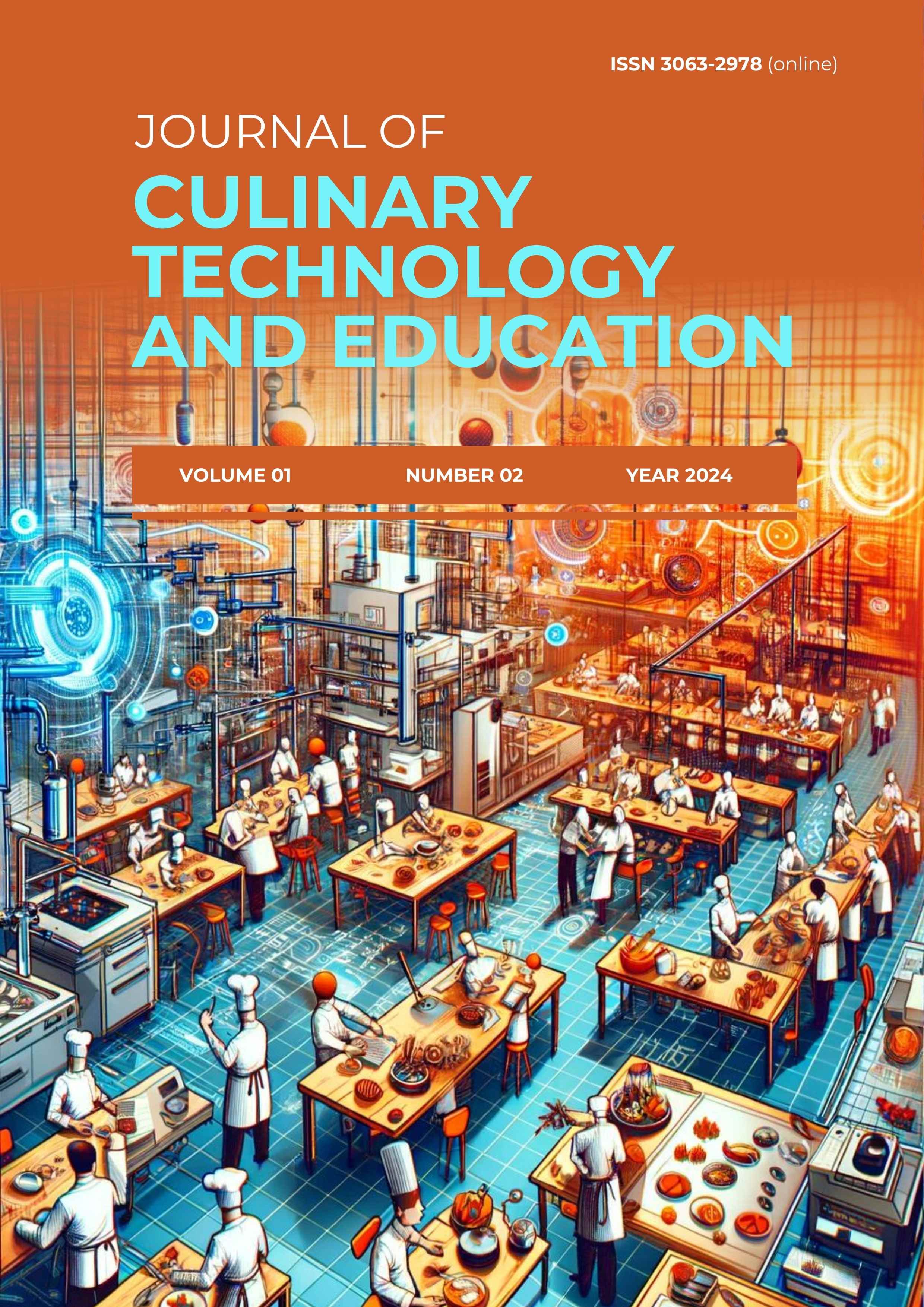The correlation among knowledge, attitude, and ınstant food and beverage consumption patterns on the nutritional status of culinary students
DOI:
https://doi.org/10.21831/jcte.v1i2.666Keywords:
Attitudes, behaviors, instant food and beverages, knowledge, nutritional statusAbstract
This study seeks to ascertain: (1) the nutritional knowledge level of class XII Culinary students; (2) the attitudes of class XII Culinary students towards the consumption of instant food and beverages; (3) the behaviors of class XII Culinary students concerning the consumption of instant food and beverages; (4) the nutritional status of class XII Culinary students; (5) the correlation between the knowledge of class XII Culinary students and their nutritional status regarding the consumption of instant food and beverages; (6) the correlation between attitudes and the nutritional status of class XII Culinary students in relation to the consumption of instant food and beverages; (7) the correlation between behaviors and the nutritional status of class XII Culinary students at SMK Negeri 3 Wonosari regarding the consumption of instant food and beverages. This research employs a quantitative descriptive methodology. The population comprised 103 pupils, with a sample of 87 individuals selected using the Isaac and Michael table and the Simple Random Sampling method. The data analysis employed the Chi-Square test, namely univariate and bivariate analysis. The findings indicated that the majority of students possessed adequate nutritional knowledge and favorable attitudes towards healthy eating habits; however, the study revealed no significant correlation between nutritional knowledge (p = 0.550), attitudes (p = 0.974), and the consumption of instant food (p = 0.221) concerning students' nutritional status. The nutritional status of the majority of pupils was classified as overweight (39.1%), normal (36.8%), and underweight (20.7%). These findings indicate the necessity for extensive educational programs to enhance healthy eating habits and underscore the significance of a balanced diet, particularly among adolescents. This research endorses continuous public health efforts to enhance dietary selections and general well-being among the youth.
Downloads
References
Afifah, dkk. (2017). Faktor-faktor yang berhubungan dengan konsumsi fast food pada remaja obesitas di SMA Theresiana 1 Semarang. Jurnal Kesehatan Masyarakat, 5(4), 706–713. Semarang: Universitas Diponegoro.
Asakura, K., Mori, S., Sasaki, S., & Nishiwaki, Y. (2021). A school-based nutrition education program involving children and their guardians in Japan: Facilitation of guardian-child communication and reduction of nutrition knowledge disparity. Nutrition Journal, 20(1). https://doi.org/10.1186/s12937-021-00751-z
Baker, P., & Friel, S. (2014). Processed foods and the nutrition transition: Evidence from Asia. Obesity Reviews, 15(7), 564–577. https://doi.org/10.1111/obr.12174
Collado-Soler, R., Alférez-Pastor, M., Torres, F., Trigueros, R., Aguilar-Parra, J., & Gómez, N. (2023). A systematic review of healthy nutrition intervention programs in kindergarten and primary education. Nutrients, 15(3), 541. https://doi.org/10.3390/nu15030541
Hasibuan, S., Basuki, R., & Jati, W. (2021). Food and beverage service activities statistics. Badan Pusat Statistik Indonesia.
Hidayat, T. (2020). Analisis persepsi konsumen terhadap pembelian makanan secara online saat pandemi Covid–19 (Kasus fitur Go-Food) (Tesis doktoral, Universitas Sumatera Utara).
Kholyfah, M. N., Nurjanah, N., Aliah, N., & Suminar, E. R. (2023). Hubungan pengetahuan gizi pranikah terhadap status gizi dan sikap catin dalam upaya pencegahan stunting di KUA Kesambi Kota Cirebon tahun 2023. Midwife's Research, 12(1).
Kotler, P., & Keller, L. (2016). Marketing management (15th ed.). Pearson Prentice Hall.
Kurdanti, W., Suryani, I., Syamsiatun, N. H., Siwi, L. P., & Adityanti, M. M. (2014). Faktor-faktor yang memengaruhi kejadian obesitas pada remaja. Jurnal Gizi Klinik Indonesia, 11(4), 179–190.
Martyniuk, O., Vanderloo, L., Irwin, J., Burke, S., & Tucker, P. (2016). Comparing the nutrition environment and practices of home- and centre-based child-care facilities. Public Health Nutrition, 19(4), 575–584. https://doi.org/10.1017/s1368980015003535
Myszkowska-Ryciak, J., & Harton, A. (2018). Education on healthy eating improved nutrition-related practices in Polish preschools. Health Problems of Civilization, 12(4), 238–246. https://doi.org/10.5114/hpc.2018.79986
Nasrudin, F. A., Rumagit, M. E., & Pascoal, M. E. (2016). Hubungan frekuensi konsumsi makanan jajanan dengan status gizi dan prestasi belajar anak Sekolah Dasar Negeri Malalayang Kota.
Nor, N., Ghozali, A., & Ismail, J. (2019). Prevalence of overweight and obesity among children and adolescents with autism spectrum disorder and associated risk factors. Frontiers in Pediatrics, 7. https://doi.org/10.3389/fped.2019.00038
Notoatmodjo, S. (2010). Prinsip-prinsip dasar ilmu kesehatan masyarakat. Rineka Cipta.
Notoatmodjo, S. (2014). Promosi kesehatan dan perilaku kesehatan. Rineka Cipta.
Sahal, U. (2024). Banyak kasus cuci darah pada anak, ini pesan pakar kesehatan UM Surabaya. UM Surabaya. https://www.um-surabaya.ac.id/article/viral-banyak-kasus-cuci-darah-pada-anak-ini-pesan-pakar-kesehatan-um-surabaya
Setyawan, F., Panunggal, B., Syauqy, A., & Rahadiyanti, A. (2018). Hubungan pengetahuan dan sikap gizi dengan perilaku makan dari luar rumah pada remaja di Kota Surakarta. Journal of Nutrition College, 8(4), 187–195.
Siregar, G. D., Kapantow, N. H., & Punuh, M. I. (2023). Hubungan pengetahuan gizi seimbang dengan status gizi remaja putri di SMA Negeri 4 Manado. JPAI: Jurnal Perempuan dan Anak Indonesia, 5(1), 27–33.
Ubro, I. (2014). Hubungan antara asupan energi dengan status gizi mahasiswa program studi pendidikan dokter angkatan 2013 Fakultas Kedokteran Universitas Sam Ratulangi. Jurnal e-Biomedik, 2(1).
Wahyuni, S. (2017). Dampak MSG bagi kesehatan anak. Pascasarjana Universitas Jember.
Wakwoya, E. (2023). Effect of intensive nutrition education and counseling on hemoglobin level of pregnant women in East Shoa Zone, Ethiopia: Randomized controlled trial. BMC Pregnancy and Childbirth, 23(1). https://doi.org/10.1186/s12884-023-05992-w
Wang, D., Stewart, D., Chang, C., & Shi, Y. (2015). Effect of a school-based nutrition education program on adolescents’ nutrition-related knowledge, attitudes and behaviour in rural areas of China. Environmental Health and Preventive Medicine, 20(4), 271–278. https://doi.org/10.1007/s12199-015-0456-4
Whitehead, L., & Seaton, P. (2016). The effectiveness of self-management mobile phone and tablet apps in long-term condition management: A systematic review. Journal of Medical Internet Research, 18(5), e97. https://doi.org/10.2196/jmir.4883
World Health Organization. (2016). Obesity: Preventing and managing the global epidemic: Technical report series. http://www.who.int/topics/obesity/en/
Widhalm, K., Helk, O., & Pachinger, O. (2018). The Viennese Eddy study as a role model for obesity: Prevention by means of nutritional and lifestyle interventions. Obesity Facts, 11(3), 247–256. https://doi.org/10.1159/000481140
Xu, Y., Bi, X., Gao, T., Yang, T., Xu, P., Gan, Q., & Zhang, Q. (2022). Effect of school-based nutrition and health education for rural Chinese children. Nutrients, 14(19), 3997. https://doi.org/10.3390/nu14193997
Zerfu, T., & Biadgilign, S. (2018). Pregnant mothers have limited knowledge and poor dietary diversity practices, but favorable attitude towards nutritional recommendations in rural Ethiopia: Evidence from community-based study. BMC Nutrition, 4(1). https://doi.org/10.1186/s40795-018-0251-x
Zhao, Y., & Araki, T. (2024). Diet quality and its associated factors among adults with overweight and obesity: Findings from the 2015–2018 National Health and Nutrition Examination Survey. British Journal of Nutrition, 131(1), 134-142.
Downloads
Published
How to Cite
Issue
Section
Citation Check
License
Copyright (c) 2024 Nafiah Adhuha Ramadhani, Titin Hera Widi Handayani

This work is licensed under a Creative Commons Attribution-ShareAlike 4.0 International License.







